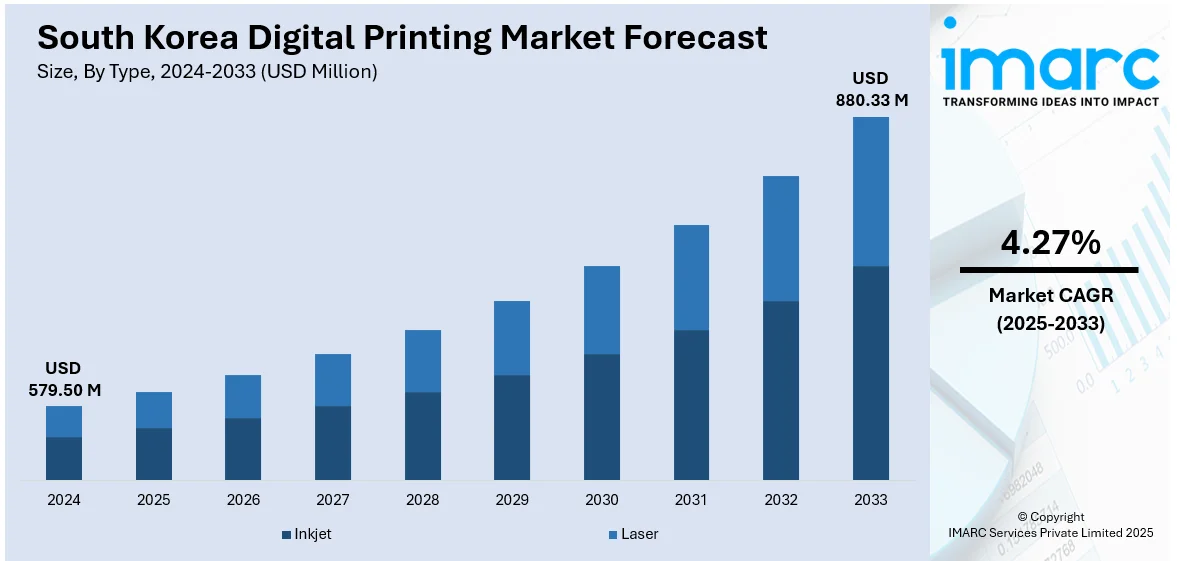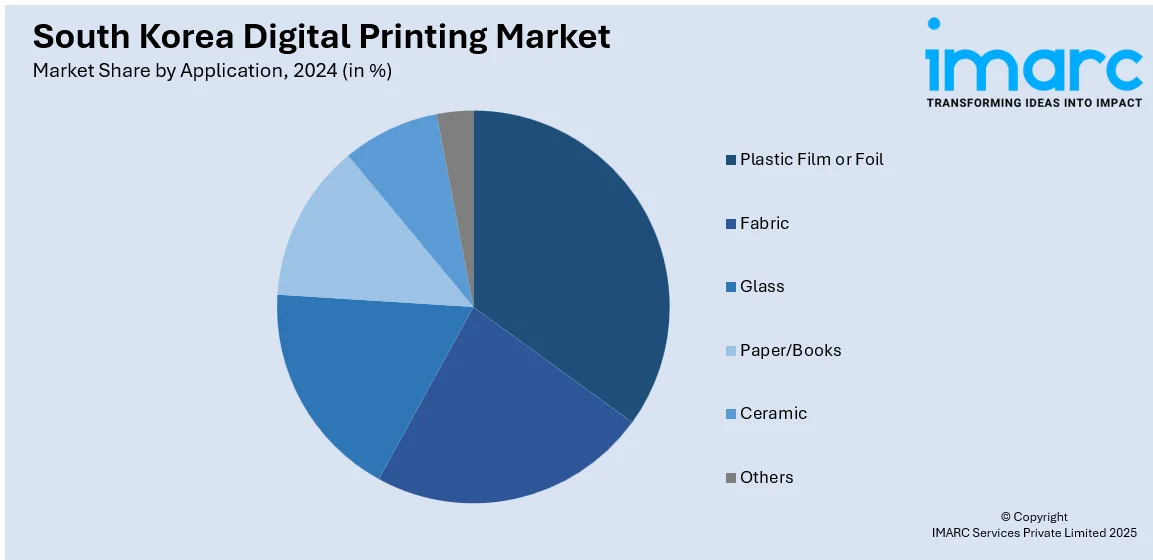
South Korea Digital Printing Market Size, Share, Trends and Forecast by Type, Ink Type, Application, and Region, 2025-2033
South Korea Digital Printing Market Overview:
The South Korea digital printing market size reached USD 579.50 Million in 2024. The market is projected to reach USD 880.33 Million by 2033, exhibiting a growth rate (CAGR) of 4.27% during 2025-2033. The market is driven by rapid digital transformation, strong government support for smart manufacturing, and rising adoption of cloud-connected printing systems. Additionally, the increasing need for customized packaging and on-demand production especially in e-commerce, cosmetics, and food sectors pushes businesses toward flexible, short-run digital print solutions that enable faster turnaround, design agility, and targeted consumer engagement thus aiding the South Korea digital printing market share.
|
Report Attribute
|
Key Statistics
|
|---|---|
|
Base Year
|
2024
|
|
Forecast Years
|
2025-2033
|
|
Historical Years
|
2019-2024
|
| Market Size in 2024 | USD 579.50 Million |
| Market Forecast in 2033 | USD 880.33 Million |
| Market Growth Rate 2025-2033 | 4.27% |
South Korea Digital Printing Market Trends:
Customized Packaging & On‑Demand Production
Increased demand for customized, short-run printing services is one of the biggest drivers of the South Korea digital printing market growth. More companies are addressing specialized niches and customized tastes of individual consumers, making digital printing the preferred means for generating customized packaging, labels, and marketing materials. Traditional printing, which involves high volume to be economically viable, cannot compete with digital printing, which makes rapid modification, batch sizes, and quick turnaround possible. This is particularly valuable in business sectors such as food, cosmetics, and web retail, where brands must be constantly changing packaging and designs. On-demand printing also enables local manufacture and minimizes storage requirements, allowing businesses to react more nimbly to trends in the marketplace. The opportunity to produce custom, attention-grabbing material in short order makes digital printing critical to contemporary branding and product differentiation.

To get more information on this market, Request Sample
Sustainability & Eco-Friendly Demand
Environmental awareness is increasingly influencing consumer and corporate behavior in South Korea, and the printing industry is adapting in response. Digital printing aligns with sustainability goals by reducing waste and using fewer harmful chemicals. Globally, 65% of companies using digital workflows have minimized waste, and vegetable-based inks have cut VOC emissions by 40–50%, reinforcing its eco-friendly advantages. South Korean companies are actively adopting green alternatives, including energy-efficient digital printers and recyclable substrates. Consumers are also demanding more environmentally responsible packaging and production methods, prompting brands to rethink traditional, chemical-intensive print processes. Digital printing enables cleaner, on-demand production with less material usage and supports short runs, lowering environmental impact. This flexibility allows businesses to maintain high-quality output while advancing their sustainability initiatives. As green practices gain momentum, digital printing emerges as a strategic solution that helps balance performance, cost-effectiveness, and ecological responsibility in evolving South Korea digital printing market outlook.
Government Initiatives & Digital Transformation
The government of South Korea is the primary driver of digital print growth, due to its robust push for digitalization across various sectors. Government initiatives like smart factories, e-government, and the upgrade of digital infrastructure encourage companies and institutions to embrace modern technologies. This change has a direct implication on the printing industry, as most organizations are transitioning from analog to digital systems that bring in the capability of automation, speed, and full connectivity. The nation's strong internet and fifth generation (5G) networks further enable cloud-based printing and remote management, making work processes more efficient. As education, healthcare, and public services become more digital, there is greater demand for cutting-edge printing technologies that can manage customized, data-driven output. These are not simply efforts to upgrade equipment—they're efforts to put digital printing within a larger innovation system that captures South Korea's vision of a smarter, interconnected industrial future, one in which printing enables agility, sustainability, and digital efficiency.
South Korea Digital Printing Market Segmentation:
IMARC Group provides an analysis of the key trends in each segment of the market, along with forecasts at the country and regional levels for 2025-2033. Our report has categorized the market based on type, ink type, and application.
Type Insights:
- Inkjet
- Laser
The report has provided a detailed breakup and analysis of the market based on the type. This includes inkjet and laser.
Ink Type Insights:
- Aqueous Ink
- UV-Cured Ink
- Solvent Ink
- Latex Ink
- Dye Sublimation Ink
A detailed breakup and analysis of the market based on the ink type have also been provided in the report. This includes aqueous ink, UV-cured ink, solvent ink, latex ink, and dye sublimation ink.
Application Insights:

- Plastic Film or Foil
- Fabric
- Glass
- Paper/Books
- Ceramic
- Others
A detailed breakup and analysis of the market based on the application have also been provided in the report. This includes plastic film or foil, fabric, glass, paper/books, ceramic, and others.
Regional Insights:
- Seoul Capital Area
- Yeongnam (Southeastern Region)
- Honam (Southwestern Region)
- Hoseo (Central Region)
- Others
The report has also provided a comprehensive analysis of all the major regional markets, which include Seoul Capital Area, Yeongnam (Southeastern Region), Honam (Southwestern Region), Hoseo (Central Region), and others.
Competitive Landscape:
The market research report has also provided a comprehensive analysis of the competitive landscape. Competitive analysis such as market structure, key player positioning, top winning strategies, competitive dashboard, and company evaluation quadrant has been covered in the report. Also, detailed profiles of all major companies have been provided.
South Korea Digital Printing Market News:
- In July 2024, Xeikon appointed Digital Print Asia as its regional distributor for digital presses across Asia, including South Korea, Singapore, Malaysia, Thailand, and the Philippines. Led by industry veterans Alex Tan and Bent Serritslev, the partnership aims to expand Xeikon’s presence and service quality in the region. Local partners like S&H Hitech in South Korea will support this rollout, ensuring strong customer service and access to Xeikon’s advanced digital printing solutions.
South Korea Digital Printing Market Report Coverage:
| Report Features | Details |
|---|---|
| Base Year of the Analysis | 2024 |
| Historical Period | 2019-2024 |
| Forecast Period | 2025-2033 |
| Units | Million USD |
| Scope of the Report |
Exploration of Historical Trends and Market Outlook, Industry Catalysts and Challenges, Segment-Wise Historical and Future Market Assessment:
|
| Types Covered | Inkjet, Laser |
| Ink Types Covered | Aqueous Ink, UV-Cured Ink, Solvent Ink, Latex Ink, Dye Sublimation Ink |
| Applications Covered | Plastic Film or Foil, Fabric, Glass, Paper/Books, Ceramic, Others |
| Regions Covered | Seoul Capital Area, Yeongnam (Southeastern Region), Honam (Southwestern Region), Hoseo (Central Region), Others |
| Customization Scope | 10% Free Customization |
| Post-Sale Analyst Support | 10-12 Weeks |
| Delivery Format | PDF and Excel through Email (We can also provide the editable version of the report in PPT/Word format on special request) |
Key Questions Answered in This Report:
- How has the South Korea digital printing market performed so far and how will it perform in the coming years?
- What is the breakup of the South Korea digital printing market on the basis of type?
- What is the breakup of the South Korea digital printing market on the basis of ink type?
- What is the breakup of the South Korea digital printing market on the basis of application?
- What is the breakup of the South Korea digital printing market on the basis of region?
- What are the various stages in the value chain of the South Korea digital printing market?
- What are the key driving factors and challenges in the South Korea digital printing market?
- What is the structure of the South Korea digital printing market and who are the key players?
- What is the degree of competition in the South Korea digital printing market?
Key Benefits for Stakeholders:
- IMARC’s industry report offers a comprehensive quantitative analysis of various market segments, historical and current market trends, market forecasts, and dynamics of the South Korea digital printing market from 2019-2033.
- The research report provides the latest information on the market drivers, challenges, and opportunities in the South Korea digital printing market.
- Porter's five forces analysis assist stakeholders in assessing the impact of new entrants, competitive rivalry, supplier power, buyer power, and the threat of substitution. It helps stakeholders to analyze the level of competition within the South Korea digital printing industry and its attractiveness.
- Competitive landscape allows stakeholders to understand their competitive environment and provides an insight into the current positions of key players in the market.
Need more help?
- Speak to our experienced analysts for insights on the current market scenarios.
- Include additional segments and countries to customize the report as per your requirement.
- Gain an unparalleled competitive advantage in your domain by understanding how to utilize the report and positively impacting your operations and revenue.
- For further assistance, please connect with our analysts.
 Request Customization
Request Customization
 Speak to an Analyst
Speak to an Analyst
 Request Brochure
Request Brochure
 Inquire Before Buying
Inquire Before Buying




.webp)




.webp)












